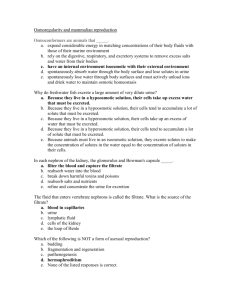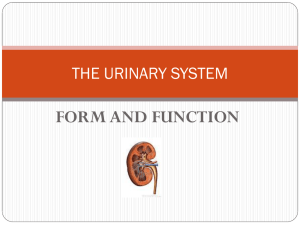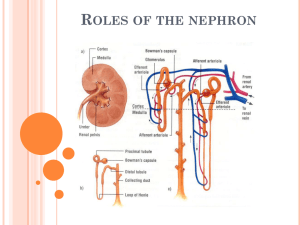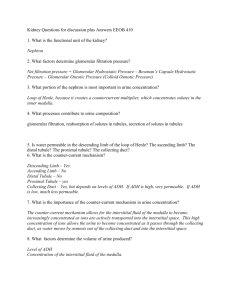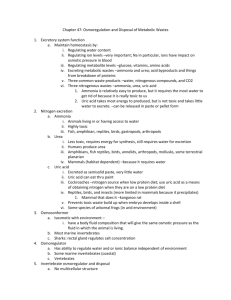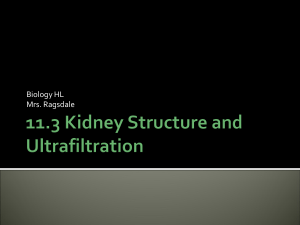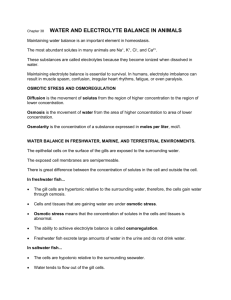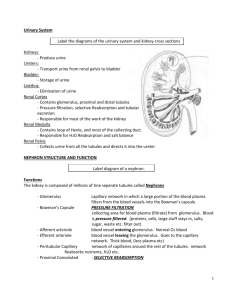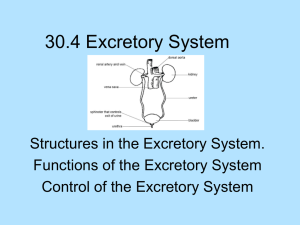topic17
advertisement
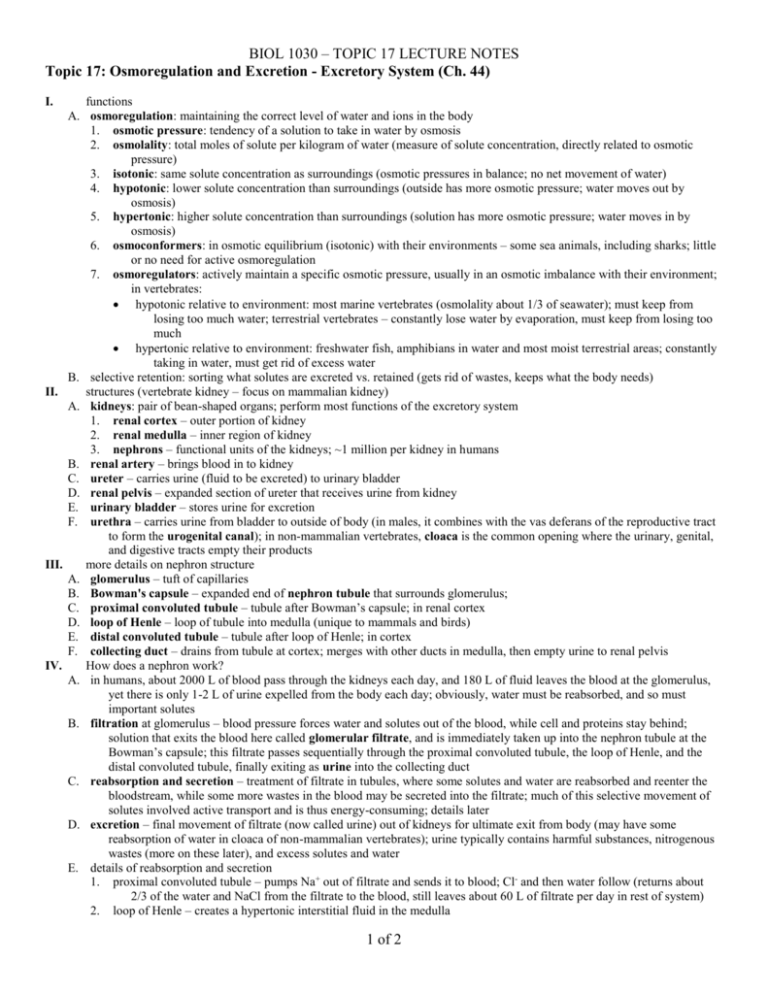
BIOL 1030 – TOPIC 17 LECTURE NOTES Topic 17: Osmoregulation and Excretion - Excretory System (Ch. 44) I. functions A. osmoregulation: maintaining the correct level of water and ions in the body 1. osmotic pressure: tendency of a solution to take in water by osmosis 2. osmolality: total moles of solute per kilogram of water (measure of solute concentration, directly related to osmotic pressure) 3. isotonic: same solute concentration as surroundings (osmotic pressures in balance; no net movement of water) 4. hypotonic: lower solute concentration than surroundings (outside has more osmotic pressure; water moves out by osmosis) 5. hypertonic: higher solute concentration than surroundings (solution has more osmotic pressure; water moves in by osmosis) 6. osmoconformers: in osmotic equilibrium (isotonic) with their environments – some sea animals, including sharks; little or no need for active osmoregulation 7. osmoregulators: actively maintain a specific osmotic pressure, usually in an osmotic imbalance with their environment; in vertebrates: hypotonic relative to environment: most marine vertebrates (osmolality about 1/3 of seawater); must keep from losing too much water; terrestrial vertebrates – constantly lose water by evaporation, must keep from losing too much hypertonic relative to environment: freshwater fish, amphibians in water and most moist terrestrial areas; constantly taking in water, must get rid of excess water B. selective retention: sorting what solutes are excreted vs. retained (gets rid of wastes, keeps what the body needs) II. structures (vertebrate kidney – focus on mammalian kidney) A. kidneys: pair of bean-shaped organs; perform most functions of the excretory system 1. renal cortex – outer portion of kidney 2. renal medulla – inner region of kidney 3. nephrons – functional units of the kidneys; ~1 million per kidney in humans B. renal artery – brings blood in to kidney C. ureter – carries urine (fluid to be excreted) to urinary bladder D. renal pelvis – expanded section of ureter that receives urine from kidney E. urinary bladder – stores urine for excretion F. urethra – carries urine from bladder to outside of body (in males, it combines with the vas deferans of the reproductive tract to form the urogenital canal); in non-mammalian vertebrates, cloaca is the common opening where the urinary, genital, and digestive tracts empty their products III. more details on nephron structure A. glomerulus – tuft of capillaries B. Bowman's capsule – expanded end of nephron tubule that surrounds glomerulus; C. proximal convoluted tubule – tubule after Bowman’s capsule; in renal cortex D. loop of Henle – loop of tubule into medulla (unique to mammals and birds) E. distal convoluted tubule – tubule after loop of Henle; in cortex F. collecting duct – drains from tubule at cortex; merges with other ducts in medulla, then empty urine to renal pelvis IV. How does a nephron work? A. in humans, about 2000 L of blood pass through the kidneys each day, and 180 L of fluid leaves the blood at the glomerulus, yet there is only 1-2 L of urine expelled from the body each day; obviously, water must be reabsorbed, and so must important solutes B. filtration at glomerulus – blood pressure forces water and solutes out of the blood, while cell and proteins stay behind; solution that exits the blood here called glomerular filtrate, and is immediately taken up into the nephron tubule at the Bowman’s capsule; this filtrate passes sequentially through the proximal convoluted tubule, the loop of Henle, and the distal convoluted tubule, finally exiting as urine into the collecting duct C. reabsorption and secretion – treatment of filtrate in tubules, where some solutes and water are reabsorbed and reenter the bloodstream, while some more wastes in the blood may be secreted into the filtrate; much of this selective movement of solutes involved active transport and is thus energy-consuming; details later D. excretion – final movement of filtrate (now called urine) out of kidneys for ultimate exit from body (may have some reabsorption of water in cloaca of non-mammalian vertebrates); urine typically contains harmful substances, nitrogenous wastes (more on these later), and excess solutes and water E. details of reabsorption and secretion 1. proximal convoluted tubule – pumps Na+ out of filtrate and sends it to blood; Cl- and then water follow (returns about 2/3 of the water and NaCl from the filtrate to the blood, still leaves about 60 L of filtrate per day in rest of system) 2. loop of Henle – creates a hypertonic interstitial fluid in the medulla 1 of 2 BIOL 1030 – TOPIC 17 LECTURE NOTES V. A. B. C. D. VI. A. B. C. D. descending loop (carries filtrate into medulla) water exits because interstitial fluid of medulla is hypertonic relative to filtrate not permeable to NaCl, so little moves into filtrate glucose, amino acids, vitamins, divalent ions, etc. are moved out of filtrate via active transport (this solute reabsorption can be saturated – too much glucose in blood leads to glucose left in the urine) ascending loop (carries filtrate up from medulla) not permeable to water, but Na+ actively pumped out, drawing out Cl makes medulla hypertonic, and filtrate hypotonic (relative to blood) distal convoluted tubule – active secretion of H+, K+, and some other solutes from the blood into the filtrate; waterpermeable, and because the filtrate is hypotonic relative to blood, water leaves the filtrate and enters the blood to fix osmotic imbalance collecting duct – also water-permeable, and since filtrate (urine) is still hypotonic relative to blood, more water is removed from the urine nitrogenous wastes amino acids and nucleic acids have nitrogen in them when these are catabolized for energy or used in synthesis of other organic compounds, ammonia (NH3) is often produced; much of this occurs in the liver ammonia is very toxic; it must be kept in dilute solutions, and it must be gotten rid of in some way; three general approaches 1. flushing – bony fishes and larval amphibians secrete ammonia from the gills 2. detoxification – cartilaginous fishes, adult amphibians, and mammals convert ammonia to urea, which is much less toxic; urea is water-soluble and is concentrated in the urine for excretion 3. insolubilization – reptiles and birds convert ammonia to uric acid, which is not very soluble in water, so it precipitates out and can be eliminated with little loss of water (important in eggs) uric acid is also produced by mammals in nucleic acid degradation, and they use the enzyme uricase to convert it into a more soluble derivative, allantoin 1. humans, apes, and Dalmatians are the only mammals to lack this enzyme and must secrete uric acid, which can be hard to do 2. gout is an accumulation of uric acid crystals in the joints that occurs if it is not adequately removed by the kidneys regulation diuretic – something that makes urine more dilute, flushing water out of the body antidiuretic hormone (ADH, or vasopressin) – when an animal needs to conserve water, the posterior pituitary releases ADH, which increases the number of water channels in the plasma membranes of the epithelial cells of the collecting ducts, so that more water is reabsorbed aldosterone – hormone secreted by the adrenal cortex in response to low blood Na + concentration; causes more Na+ reabsorption in distal convoluted tubules, leads to greater retention of salt and water, increasing blood volume atrial natriuretic hormone – secreted by the right atrium of the heart when stretched by increased blood volume; leads to greater excretion of salt and water, lowering blood volume 2 of 2
